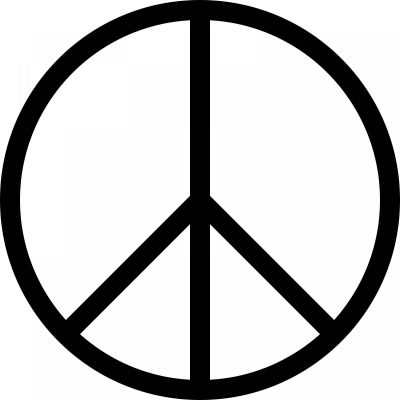A number of peace symbols have been used many ways in various cultures and contexts. The dove and olive branch was used symbolically by early Christians and then eventually became a secular peace symbol, popularized by a Dove lithograph by Pablo Picasso after World War II. In the 1950s the "peace sign", as it is known today (also known as "peace and love"), was designed by Gerald Holtom as the logo for the British Campaign for Nuclear Disarmament (CND), a group at the forefront of the peace movement in the UK, and adopted by anti-war and counterculture activists in the US and elsewhere. The symbol is a super-imposition of the semaphore signals for the letters "N" and "D", taken to stand for "nuclear disarmament", while simultaneously acting as a reference to Goya's The Third of May 1808 (1814) (aka "Peasant Before the Firing Squad").The V hand signal and the peace flag also became international peace symbols.
The Campaign for Nuclear Disarmament (CND) is an organisation that advocates unilateral nuclear disarmament by the United Kingdom, international nuclear disarmament and tighter international arms regulation through agreements such as the Nuclear Non-Proliferation Treaty. It opposes military action that may result in the use of nuclear, chemical or biological weapons and the building of nuclear power stations in the UK.
CND began in November 1957 when a committee was formed, including Canon John Collins as chairman, Bertrand Russell as president and Peggy Duff as organising secretary. The committee organised CND's first public meeting at Methodist Central Hall, Westminster, on 17 February 1958. Since then, CND has periodically been at the forefront of the peace movement in the UK. It claims to be Europe's largest single-issue peace campaign. Between 1958 and 1965 it organised the Aldermaston March, which was held over the Easter weekend from the Atomic Weapons Establishment near Aldermaston to Trafalgar Square, London.

1958Apr, 4
The CND peace symbol is displayed in public for the first time in London.
Choose Another Date
Events on 1958
- 13May
Richard Nixon
During a visit to Caracas, Venezuela, Vice President Richard Nixon's car is attacked by anti-American demonstrators. - 30May
Arlington National Cemetery
Memorial Day: The remains of two unidentified American servicemen, killed in action during World War II and the Korean War respectively, are buried at the Tomb of the Unknown Soldier in Arlington National Cemetery. - 16Jun
Hungarian Revolution of 1956
Imre Nagy, Pál Maléter and other leaders of the 1956 Hungarian Uprising are executed. - 18Aug
Lolita
Vladimir Nabokov's controversial novel Lolita is published in the United States. - 28Nov
French colonial empire
Chad, the Republic of the Congo, and Gabon become autonomous republics within the French Community.

 English
English  español
español  français
français  português
português  русский
русский  العربية
العربية  简体中文
简体中文 